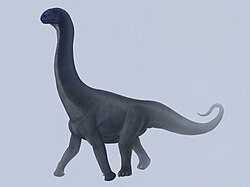Top Qs
Timeline
Chat
Perspective
1841 in paleontology
From Wikipedia, the free encyclopedia
Remove ads
Paleontology or palaeontology is the study of prehistoric life forms on Earth through the examination of plant and animal fossils.[1] This includes the study of body fossils, tracks (ichnites), burrows, cast-off parts, fossilised feces (coprolites), palynomorphs and chemical residues. Because humans have encountered fossils for millennia, paleontology has a long history both before and after becoming formalized as a science. This article records significant discoveries and events related to paleontology that occurred or were published in the year 1841.
Remove ads
Dinosaurs
- On June 30, Sir Richard Owen presents his findings regarding some enormous bones that the Reverend William Buckland had acquired at an earlier date. He names the new genus to which these bones belong "Cetiosaurus." This event marks the first scientific description of a sauropod.[2]
- Owen presents his treatise on British fossil reptiles to the British Association in August. This treatise marks the creation of a taxon called "Dinosauria."[2]
Newly named dinosaurs
Remove ads
Plesiosaurs
New taxa
Synapsids
Non-mammalian
References
Wikiwand - on
Seamless Wikipedia browsing. On steroids.
Remove ads

